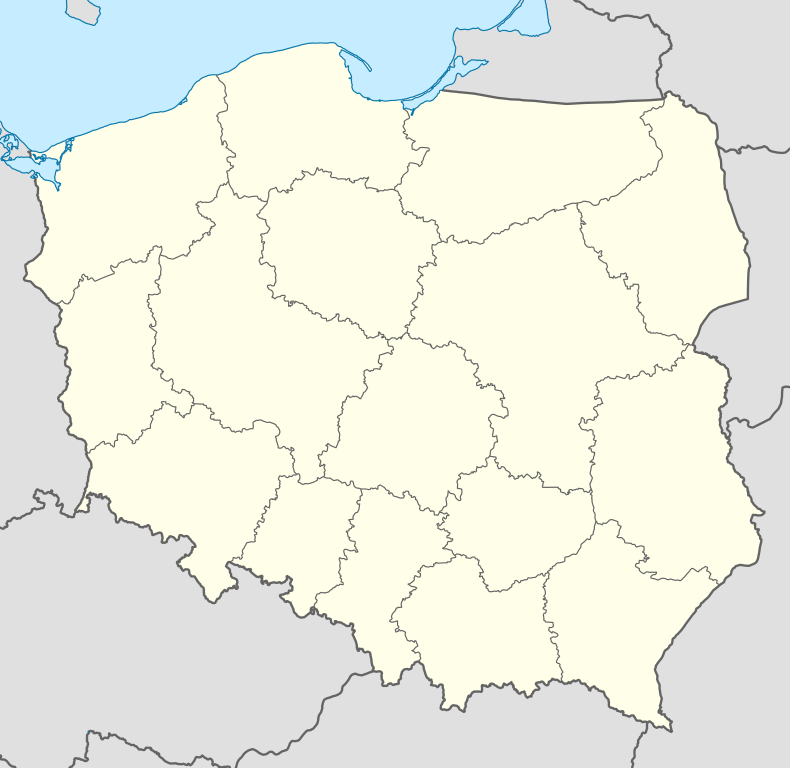Treblinka, Masovian Voivodeship
| Treblinka | |
|---|---|
| Village | |
|
Treblinka extermination camp museum | |
 Treblinka | |
| Coordinates: 52°40′N 22°01′E / 52.667°N 22.017°E | |
| Country |
|
| Voivodeship | Masovian |
| County | Ostrów Mazowiecka |
| Gmina | Gmina Małkinia Górna |
| Population | 330 |
Treblinka [trɛˈbliŋka] is a village located in eastern Poland with 350 inhabitants. It is now situated in the district of Gmina Malkinia Gorna, within Ostrów Mazowiecka County in Masovian Voivodeship, some 80 kilometres (50 miles) north-east of Warsaw. The village lies close to the Bug River.
World War II history
Treblinka was the location of Treblinka extermination camp where an estimated 850,000 people were systematically murdered during the Holocaust in Poland.[1] About 800,000 of them were Polish Jews. The first deportations took place in the course of the Grossaktion Warsaw with about 254,000 Warsaw Ghetto inmates brought in to their deaths in Holocaust trains in the summer of 1942. At the layover yard of Treblinka railway station the wagons waiting for "processing" were witnessed by Franciszek Ząbecki.[2] During the early period of the camp's operation, thousands of dead bodies of victims left unburied had accumulated to such a point that the putrid odor of decaying human remains could be smelled for approximately 10 kilometers (6.2 mi) in every direction. It was evident that mass extermination was taking place at the camp, which caused panic among the villagers.[3]
The onset of the Warsaw Ghetto Uprising inspired renewed hopes for an escape among the Treblinka Sonderkommandos. On 19 April 1943 one of the last Jewish transports of 7,000 victims along with the Warsaw insurgents were brought in for gassing. Soon later Treblinka became the first death camp ever to experience a prisoner uprising against the SS, which erupted on 2 August 1943 under the leadership of former Polish Army officer Dr. Berek Lajcher.[3]

The first commandant of the camp from July 11, 1942 until 31 August 1942 was Irmfried Eberl, relieved of his duties for not being efficient and secretive enough about the camp's murder operation.[4] He was succeeded by Franz Stangl (previously the commandant of Sobibor extermination camp) as the second commandant of Treblinka II Vernichtungslager from 1 September 1942 until the 1943 Jewish uprising.[4]
The Nazi hierarchy took measures to modify the killing process under Stangl, who built more efficient gas chambers and massive cremation pyres for the incineration of corpses.[3] When the Treblinka death camp ended operations in October 1943, the Nazis attempted (in vain) to remove all evidence of its existence and the mass murder carried out there. Relatively little physical evidence remains. It can be examined at the Treblinka museum led by Edward Kopówka, with a steadily growing number of visitors.[4] An earlier camp known as Treblinka I Arbeitslager, equipped with heavy machinery, was located 6 kilometres (3.7 mi) from Treblinka. Between June 1941 and 23 July 1944, more than half of its 20,000 inmates mining gravel for the German military road construction, died from summary executions, hunger, disease and mistreatment under Theodor van Eupen.[5]
References
- ↑ Clancy Young, Treblinka. Holocaust Research Project.
- ↑ S.J., C.L. (2007). "Franciszek Zabecki – The Station Master at Treblinka. Eyewitness to the Revolt – 2 August 1943". Holocaust Research Project.org. Holocaust Education & Archive Research Team. Retrieved 14 August 2013.
- ↑ 3.0 3.1 3.2 Kopówka, Edward; Rytel-Andrianik, Paweł (2011), "Treblinka II – Obóz zagłady" [Monograph, chpt. 3: Treblinka II Death Camp] (PDF FILE, DIRECT DOWNLOAD 20.2 MB), Dam im imię na wieki [I will give them an everlasting name. Isaiah 56:5] (in Polish) (Drohiczyńskie Towarzystwo Naukowe [The Drohiczyn Scientific Society]), ISBN 978-83-7257-496-1, retrieved 9 September 2013,
with list of Catholic rescuers of Jews imprisoned at Treblinka, selected testimonies, bibliography, alphabetical indexes, photographs, English language summaries and forewords by Holocaust scholars.
- ↑ 4.0 4.1 4.2 BBC History of World War II. Auschwitz; Inside the Nazi State. Part 3: Factories of Death.
- ↑ Maranda, Michał (2002). "Więźniowie obozu zagłady w Treblince" [Prisoners of Treblinka death camp] (PDF). Nazistowskie Obozy Zagłady. Opis i próba analizy zjawiska (Nazi extermination camps. Analysis) (in Polish). Uniwersytet Warszawski, Instytut Stosowanych Nauk Społecznych (Warsaw University Institute of Social Sciences). pp. 160–161. ISBN 83-915036-6-6. Retrieved 15 August 2013.
External links
| Wikimedia Commons has media related to Treblinka. |
- Map
- Jewish Community in Treblinka on Virtual Shtetl
| ||||||||||||
.jpg)
